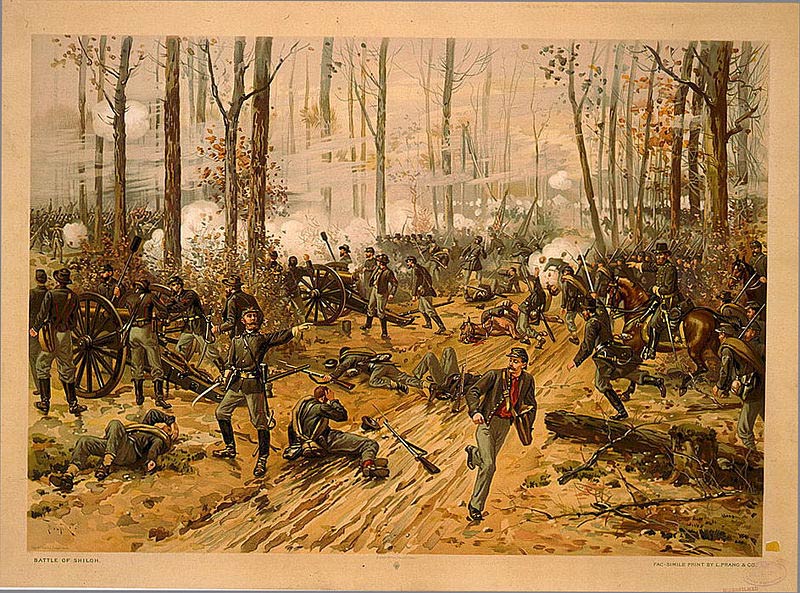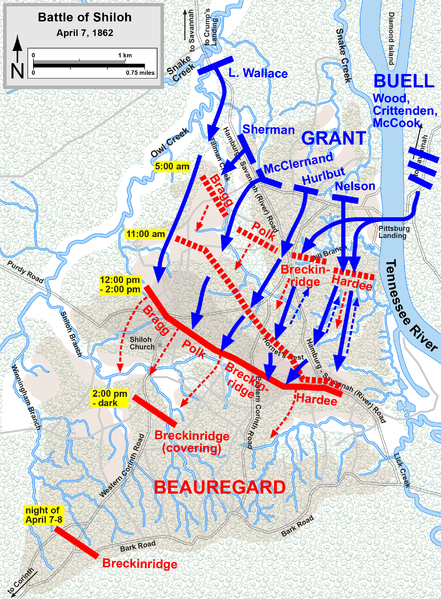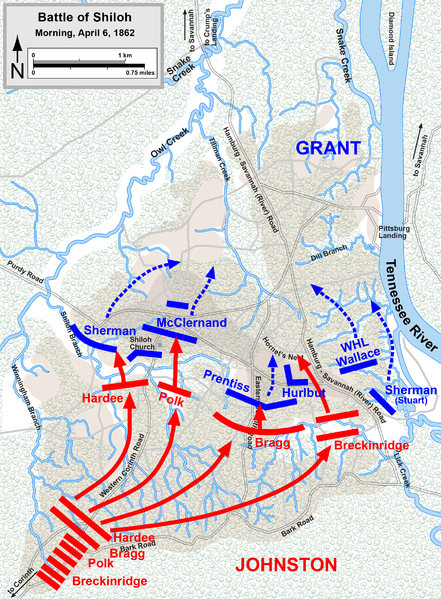| Battle of Shiloh | |||||||
|---|---|---|---|---|---|---|---|
 |
|||||||
|
|||||||
| Contenders | |||||||
| Military Leaders | |||||||
| Ulysses S. Grant Don Carlos Buell |
Albert Sidney Johnston P. G. T. Beauregard |
||||||
| Military Units in Battle | |||||||
| Army of the Tennessee Army of the Ohio |
Army of Mississippi | ||||||
| Unit Strength | |||||||
| 66,812 | 44,699 | ||||||
| Casualties and Deaths | |||||||
| Total: 13,047 | Total: 10,699 | ||||||
|
1,754 killed 8,408 wounded 2,885 captured/missing |
1,728 killed 8,012 wounded 959 captured/missing |
||||||
| Part of the American Civil War | |||||||
The Battle of Shiloh, also referred to as the Battle of Pittsburg Landing, was fought April 6 to 7, 1862, in the Western theater of southwestern Tennessee. This was considered to be one of the major early battles to be witnessed during the Civil War. It began with the Confederates under the leadership of General Albert S. Johnston launching a surprise attack on the Union troops commanded by General Ulysses S. Grant in southwestern Tennessee. The two-day battle saw the Confederates achieve a considerable victory in the first day, but they were unable to hold their position in the following day, and succumbed to the Union forces. In the end, both troops suffered massive losses with the number of casualties totaling to 23,746.
Before the Battle
In March 1862, General Henry Halleck, leading the U.S troops in the west, took the troops under Major General Grant and General Don Carlos Buell toward the south to split the Southern railroads. General Grant ascended Tennessee River using a steamboat, an camped at Pittsburg Landing, about 22 miles northeast of Corinth. Here, he established his base of operations with his forward camps being posted 2 miles inland at Shiloh Meeting House church. Halleck had advised Grant not to confront the Rebels until he got reinforcement from Buell’s Army of Ohio. On Buell’s arrival, the combined forces would proceed to Corinth and dismantle the western Confederate railroad infrastructure permanently.
On the other end, following the losses of Donelson and Forts Henry in February 1862, General Johnston of the Confederates Army was forced to vacate from Kentucky as well as leave a great deal of central and western Tennessee to the Federals. Johnston assembled his men at Corinth, Mississippi, to prepare them for any future offensive operations. This was a surprise to the Union side, whose Tennessee army would require some time to prepare for its offensive along the Tennessee River. Grant encamped at Pittsburg Landing on the west bank of the Tennessee river and spent a few days drilling raw recruits and waiting for back up from Major General Don Carlos Buell’s forces of Ohio. Johnston was aware of the location and strength of Grant, as well as the oncoming support from the Yankees; therefore, he planned to attack the vulnerable Union position on April 4. However, due to bad weather and other concerns, the attack was delayed until April 6.
April 6: Day One
At the dawn of Sunday, April 6, Johnston’s men launched a surprise attack in the region of Shiloh Church. General Grant and his troop of about 40,000 men ready for the duty were caught off guard by the onslaught. Union troops rallied nevertheless, and a bitter fight broke out on Shiloh Hill. Confederate brigades gained ground gradually throughout the morning. This forced the Federals to give way reluctantly, to fight a series of defensive positions at the Peach Orchard, Shiloh Church, Hornet’s Nest and Water Oaks Pond.
The surprise was achieving good results until later in the day when Johnston’s troops started becoming disorganized as the Federals. The attack lacked coordination as divisions, brigades and corps became entangled. In the mid afternoon, General Johnston decided to go and supervise an assault on the Union left flank. While doing this, a stray bullet shot him in the right leg, leaving him fatally wounded. Johnston died later that day, and General P. G. Beauregard became the commander of the Confederate troop. Later in the afternoon, the battered Federals established a defensive line extending from Pittsburg, anchored by rugged ravines and massed artillery at their flanks and front. Moreover, Buell’s troops had started arriving and the defense was reinforced further. The fighting went on until late in the night, however the Union army held. Beauregard was unaware of the arrival of Buell’s troop of around 40,000 men and planned to destroy Grant in another attack the following day.
April 7: Day Two
 By the dawn of April 7, the Union had a total of 45,000 men (after the arrival of Buell’s men), while the Confederates, having suffered 8,500 casualties in the previous day, had less than 20,000 effective men. To the surprise of Beauregard, the Union troops proceeded with a massive counterattack in the daybreak of April 7. The outnumbered rebels were hammered by the reinforced Federals throughout the day. Even though the confederates launched some desperate counterattacks, they became exhausted and could no longer stem the progressively more stronger Federal attack.
By the dawn of April 7, the Union had a total of 45,000 men (after the arrival of Buell’s men), while the Confederates, having suffered 8,500 casualties in the previous day, had less than 20,000 effective men. To the surprise of Beauregard, the Union troops proceeded with a massive counterattack in the daybreak of April 7. The outnumbered rebels were hammered by the reinforced Federals throughout the day. Even though the confederates launched some desperate counterattacks, they became exhausted and could no longer stem the progressively more stronger Federal attack.
The Federal forces continued attacking until they forced the Confederates back to Shiloh Church. General Beauregard proficiently removed his men and went back to Corinth, however, the Federals did not pursue them. With this battle coming to an end, the number of casualties here was more than American had witnessed in previous battles. In the end, the ultimate control of Corinth’s railroad junction still remained in doubt.
The Aftermath
Grant’s career was affected temporarily after the end of this battle, this was after Halleck combined his men and relegated Grant to the position of second-in-command. Under the leadership of Halleck, the Union armies gradually advanced toward Corinth and captured it in early May. After, the capture of Corinth, General Halleck got an extra reinforcement from General John Pope’s forces, and cautiously proceeded southward from Tennessee. Halleck was later promoted to the position of General in Chief of all Union armies, and after his exit towards east, Grant was restored to commander position. Grant would then push on down the Mississippi and siege Vicksburg in July.
On the other hand, Beauregard, received some back up from Major General Earl Dorn and his Trans-Mississippi Army. However, he advanced southward to Tupelo, deserting the most practical east-to-west rail communication in the western Confederacy. All in all, the two-day battle of Shiloh left the Confederate army defeated and 1,728 of its men dead, including their commander, Albert Johnston. Union forces suffered a casualty number of 13,047 men, with 1,754 dying in the battle including a top-ranked official General W. Wallace. Both sides suffered great losses, and none suspected that the war would continue for 3 more years, while eight larger and bloodier battles were yet to be witnessed.
